How Can AI Help With Supplier Selection?


Key Takeaways:
Artificial intelligence (AI) has started to make a real difference in how companies operate across industries.
From streamlining logistics to optimizing inventory management, AI is everywhere.
And when it comes to procurement, AI is making a significant impact, especially in supplier selection.
Why is supplier selection so crucial? Because the stakes are high.
Choosing the wrong supplier can lead to cost overruns, delays, and compromised product quality.
Naturally, companies need a way to identify the best suppliers quickly and efficiently, and that’s where AI steps in.
So, if you want to learn about the six specific ways AI does it, read on.
Traditionally, discovering new suppliers has been a time-consuming, labor-intensive task.
In fact, McKinsey found that a single supplier search can take procurement teams up to three months, with over 40 hours spent manually filtering through data.
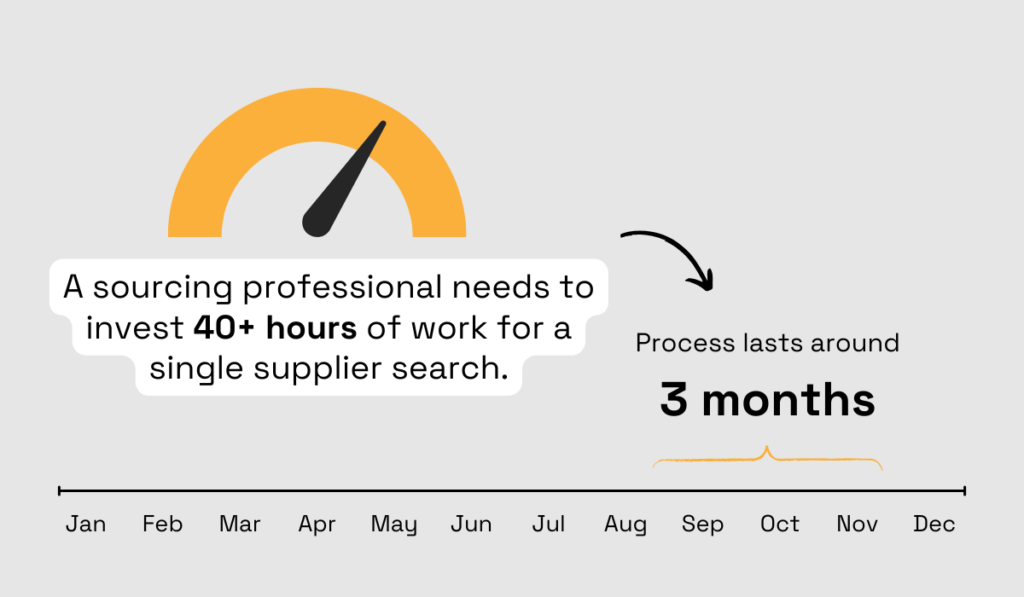
Illustration: Veridion / Data: McKinsey
But with artificial intelligence, supplier discovery shifts into high gear.
AI collects and analyzes data from multiple sources within minutes, thus automating the supplier search.
But how does AI do it?
Through supplier discovery platforms that leverage its power.
Take Veridion, for example.
With the help of AI and machine learning, Veridion constantly scans and gathers information from online sources like social media, news sites, and public records.
This AI-driven scraping happens continuously, and supplier data gets updated weekly.
Imagine that—a constantly refreshed list of suppliers without the manual effort.
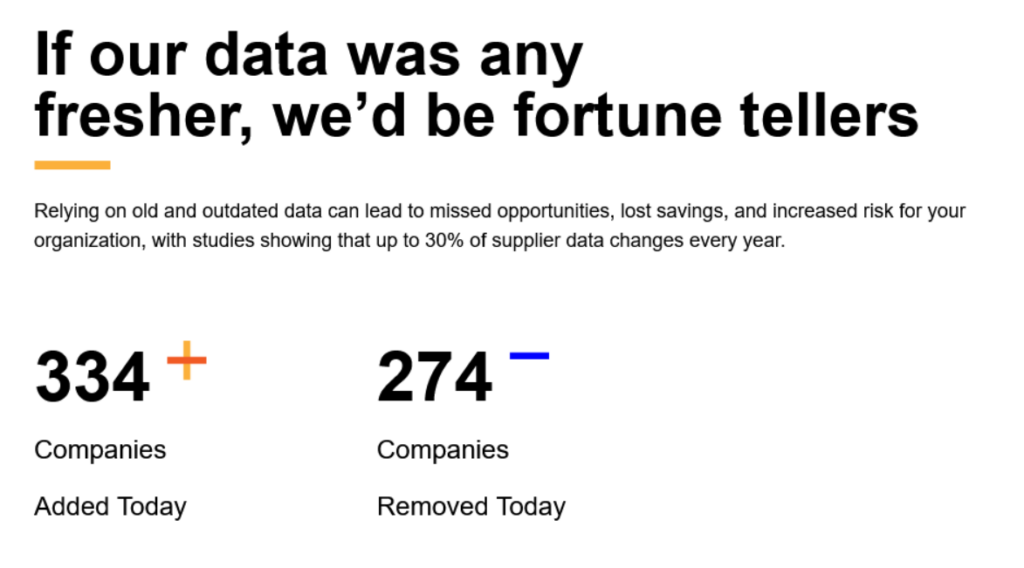
Source: Veridion
What does this really mean for procurement teams?
For starters—speed.
AI can filter through millions of suppliers in a matter of hours, providing a shortlist that meets precise criteria.
This is much faster than the traditional manual process, and it helps procurement teams reach sourcing decisions at unprecedented speeds.
In fact, the image below visualizes just how faster Veridion’s AI-powered supplier search is compared to a manual one.
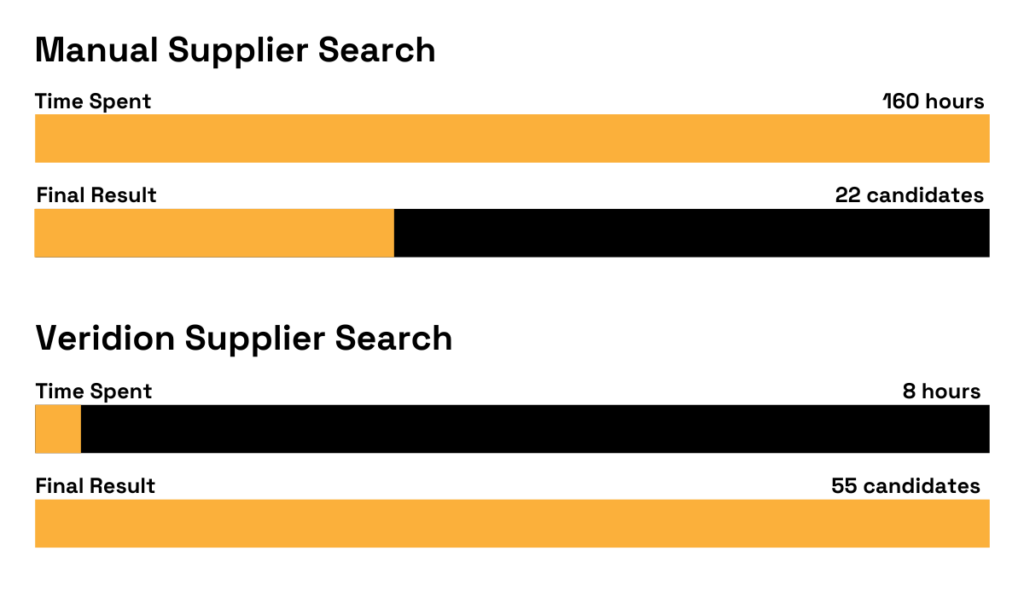
Source: Veridion
Secondly, AI can gather and analyze unmatched amounts of data.
Veridion, for instance, offers over 60 data points per supplier.
From supplier location, company size, and product offerings to certifications and ESG compliance, AI-powered Veridion provides a complete, real-time snapshot of each potential supplier.
Such in-depth, updated information helps procurement professionals make data driven decisions quickly, without missing crucial details that would put them at risk.
Given these benefits, it’s really no wonder AI-driven supplier discovery is gaining traction.
According to a 2024 Amazon Business survey, nearly half (45%) of procurement professionals plan to integrate AI into their sourcing processes within the year, and a solid 80% expect to do so within two years.
Finding suppliers is just the first step, though.
Evaluating them accurately and efficiently is where the real magic happens—and AI takes this process to a new level.
AI can analyze vast amounts of supplier data in real time, including:
Instead of making decisions based on past data or gut instinct, procurement teams now have a detailed, data driven view of each supplier, which enables faster and better choices.
And the best part is that they can get that data easily from an AI-powered system.
Take, for example, IHG Hotels & Resorts.
Their Senior VP and CPO, Sopan Shah, explains that IHG is implementing a new source-to-contract environment that uses AI to provide real-time insights.
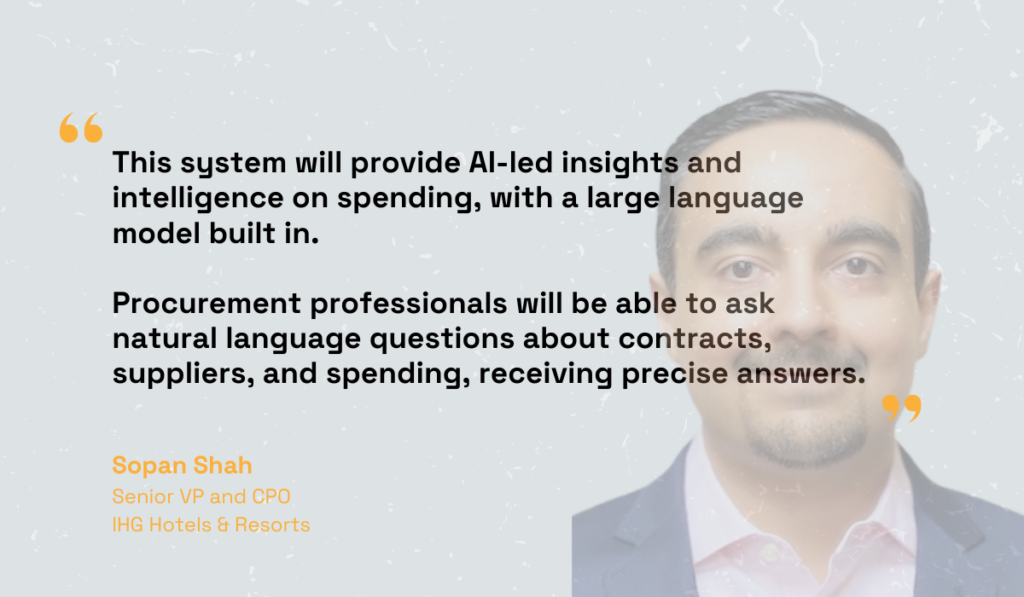
Illustration: Veridion / Quote: CPO Strategy
This system incorporates a large language model that enables procurement professionals to ask questions about contracts, suppliers, and spending in plain language and receive instant answers.
This setup lets their team focus on working with suppliers, driving innovation, and fulfilling stakeholder needs.
Such data driven supplier evaluation ensures that procurement teams aren’t just choosing suppliers based on historical data or gut feeling.
Rather, they can make evidence-based, future-focused decisions.
And as procurement becomes increasingly strategic, AI is the tool that makes such strategic decision-making possible.
Supplier risks are a significant challenge in procurement.
If a supplier faces financial difficulties, delivery delays, or other disruptions, it can throw off your entire operation.
Fortunately, AI can help you get ahead of these risks.
Instead of reacting when problems arise, AI enables you to spot risks early, allowing you to take action before they become costly.
So, how does this work?
AI analyzes both real-time and historical data to identify patterns that signal potential risks.
For example, if a supplier shows signs of financial trouble—like delayed payments or declining revenues—AI can flag these issues before they escalate.
This gives you time to find alternative suppliers or adjust your strategy well in advance.
One company that has recognized the power of AI in predicting supplier risks is Audi.
Marco Philippi, Audi’s Director of Procurement, explains:
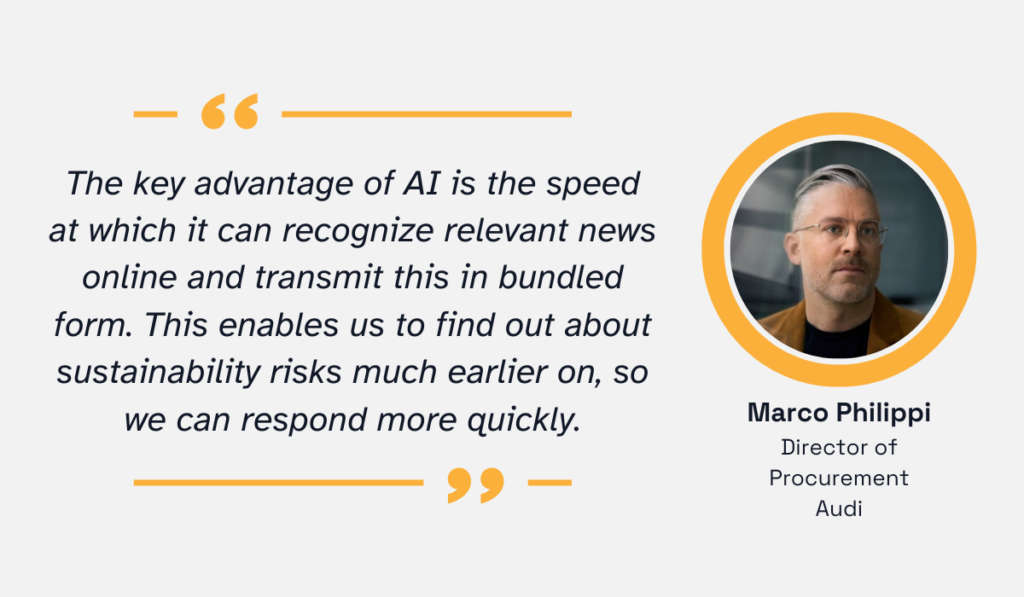
Illustration: Veridion / Quote: Prewave
Audi focuses on working with suppliers who share its sustainability values, so having real-time insight into supplier sustainability is essential for them.
To achieve that, Audi uses Prewave’s AI to detect risks, such as potential labor violations or environmental hazards.
This technology utilizes advanced speech recognition in over 50 languages to monitor online content, including social media and news articles.
This way, the tool identifies risks related to suppliers’ environmental and ethical practices early, so Audi can react on time.
In a nutshell, AI is becoming an indispensable tool for modern, risk-conscious procurement professionals.
AI-powered chatbots and automated emails are transforming supplier communication, making it faster and more efficient.
These tools handle routine tasks like gathering quotes, answering common questions, and even negotiating terms.
For procurement teams, this means speeding up supplier selection without getting bogged down with back-and-forth exchanges.
AI-driven communication is especially valuable for managing tail-end suppliers.
The thing is, tail spend—often accounting for 20% of total spend but involving up to 80% of suppliers—can be challenging to manage.
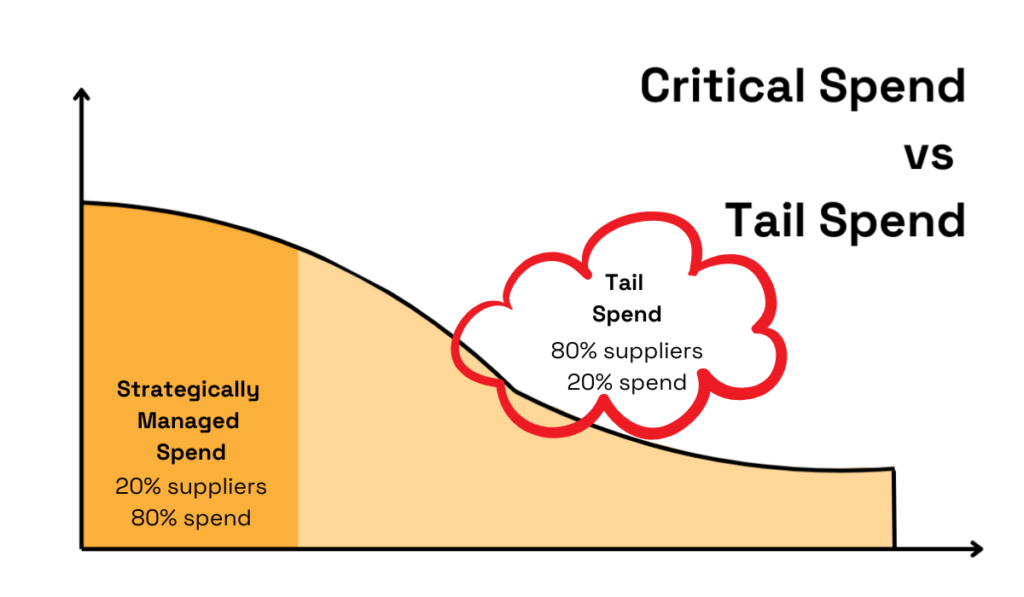
Source: Veridion
With so many suppliers, organizations rarely have the time to negotiate individually, leading to one-size-fits-all agreements that might not benefit the company.
However, the Hackett Group found that organizations actively managing tail spend can reduce annual costs by around 7.1%, proving there’s real value in addressing these smaller suppliers.
So, what does AI have to do with any of this?
Well, by automating these negotiations, AI can handle the tedious back-and-forth with each supplier, allowing businesses to get better deals without overwhelming their procurement team.
A great example of this comes from Walmart.
This retail giant deals with over 100,000 suppliers, and it’s unrealistic for them to conduct in-depth negotiations with every single one of them.
To solve this, Walmart turned to AI-powered software, Pactum AI, which uses a text-based interface (or chatbot) to negotiate directly with suppliers.
Michael DeWitt, VP of Indirect Spend Management, explains:
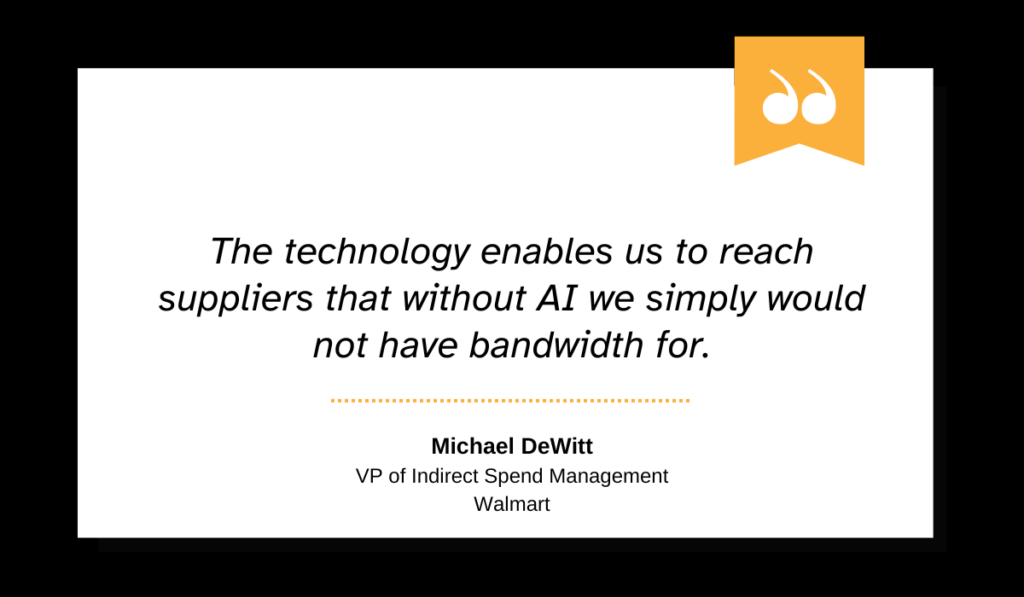
Illustration: Veridion / Quote: Harvard Business Review
The results speak for themselves.
In a pilot in Canada, Walmart used this AI tool to negotiate with 89 suppliers, achieving a success rate of 64%—well above their initial goal of 20%.
The savings averaged 1.5%, and payment terms were extended by an average of 35 days.
Since then, Walmart has expanded this to multiple countries, including the U.S., Chile, and South Africa.
Today, their AI chatbot manages up to 2,000 negotiations at once, closing deals with 68% of suppliers and achieving an average savings of 3%.
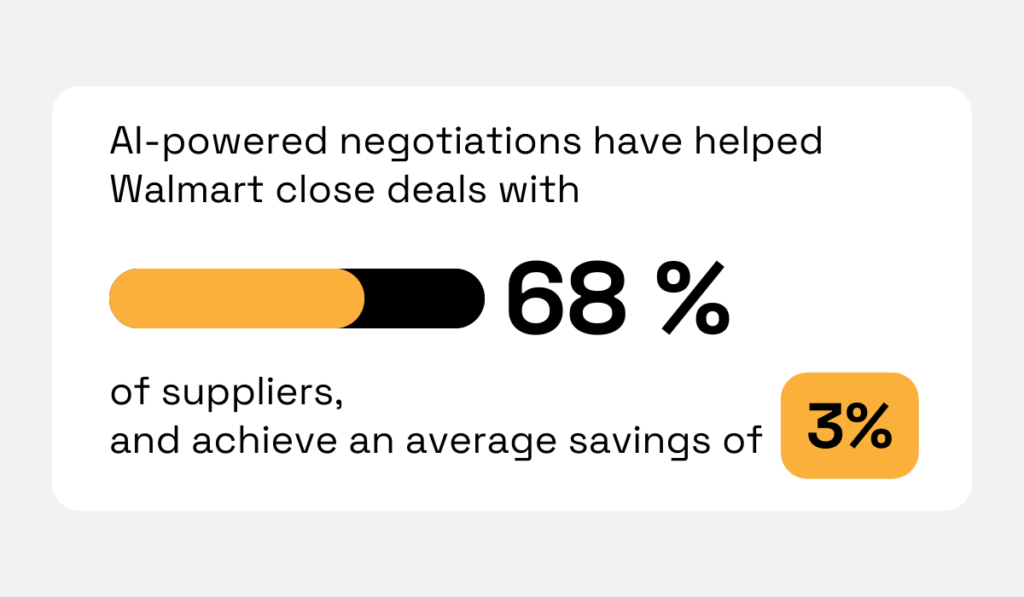
Illustration: Veridion / Data: Harvard Business Review
This shows just how scalable AI is, turning what used to be a manual, time-consuming process into an efficient, automated system.
Demand planning has always been complex, requiring insights into historical data, market intelligence, and real-time shifts in factors like seasonality or economic changes.
AI has the power to streamline this process by providing predictions that help procurement teams select suppliers who can scale production or adjust lead times accordingly.
The impact?
A streamlined supply chain, fewer stockouts or overstocks, and a reduction in costly, last-minute adjustments.
It’s no wonder, then, that spending on AI in the retail sector alone is expected to surpass $92 billion by 2031, from an estimated $9.4 billion in 2024, and with inventory management as a key focus.

Illustration: Veridion / Data: Meticulous Research
Take IKEA, a company known for its massive global reach, for example.
They invested in a tool called Demand Sensing, which uses AI to improve demand forecasting across their 450+ stores worldwide and e-commerce across 54 markets.
With over 1,600 suppliers to manage, IKEA needs precise forecasts to balance supply and demand.
Peter Grimvall, IKEA’s Head of Supply Chain Design and Planning at the time, pointed out:
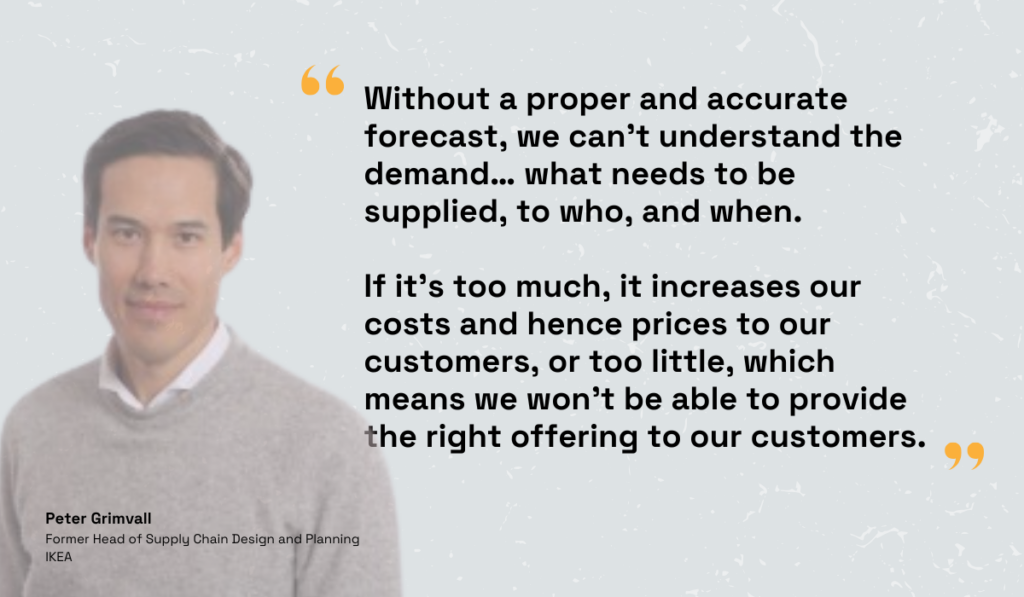
Illustration: Veridion / Quote: IKEA
Before implementing this tool, around 8% of their forecasts needed manual adjustments.
Now, thanks to AI, they’ve reduced that to just 2%.
This kind of accuracy ensures IKEA chooses suppliers that can meet their needs, whether it’s adjusting orders for a single store or preparing for global demand surges.
But it’s not just retail where AI is making a difference.
In healthcare, Johnson & Johnson uses advanced AI algorithms to get a better handle on supply and demand.
This approach prepares the company for unexpected disruptions—be it severe weather or sudden economic changes—ensuring critical products reach patients without delay.
Vishal Varma, Director of Supply Chain Digital & Data Science at Johnson & Johnson, explains:
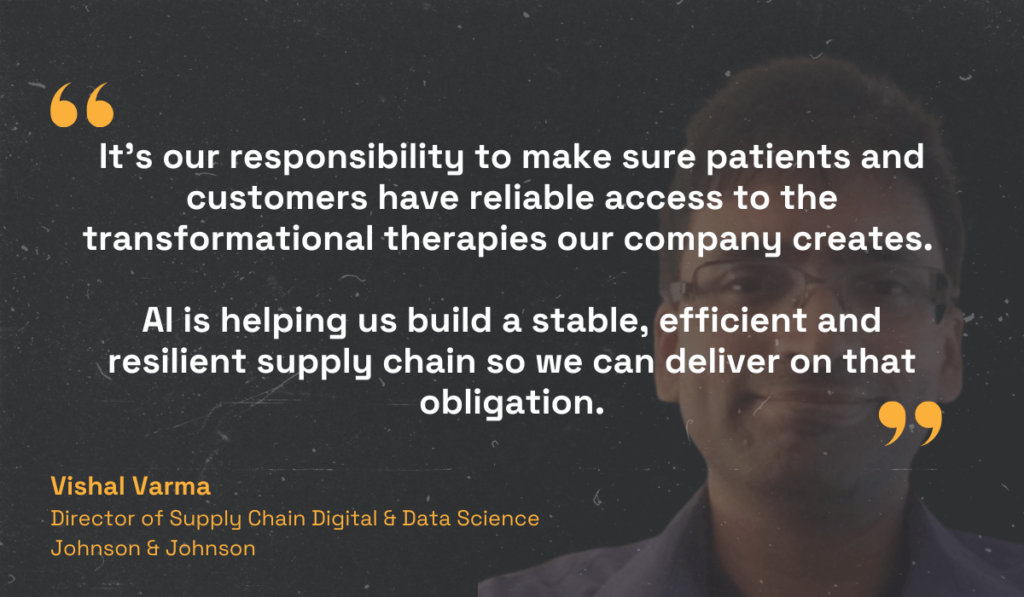
Illustration: Veridion / Quote: Johnson & Johnson
So, it all boils down to this: by predicting what your business will need ahead of time, AI helps you work smarter, not harder.
Do you spend hours sifting through supplier contracts, trying to find the best terms, spot risks, and make sure everything aligns with your business goals?
It’s tedious and time-consuming, but it’s crucial work.
Now, imagine you could cut down that effort drastically and focus on negotiating better deals or strengthening supplier relationships instead.
Well, with AI, you don’t have to imagine anymore.
By leveraging natural language processing (NLP) and optical character recognition (OCR), AI can scan and analyze contracts in a matter of minutes.
Instead of manually reading through every clause, you can get quick summaries of essential terms, compare agreements automatically, and highlight critical points.
The image below is a great example of what this can look like.
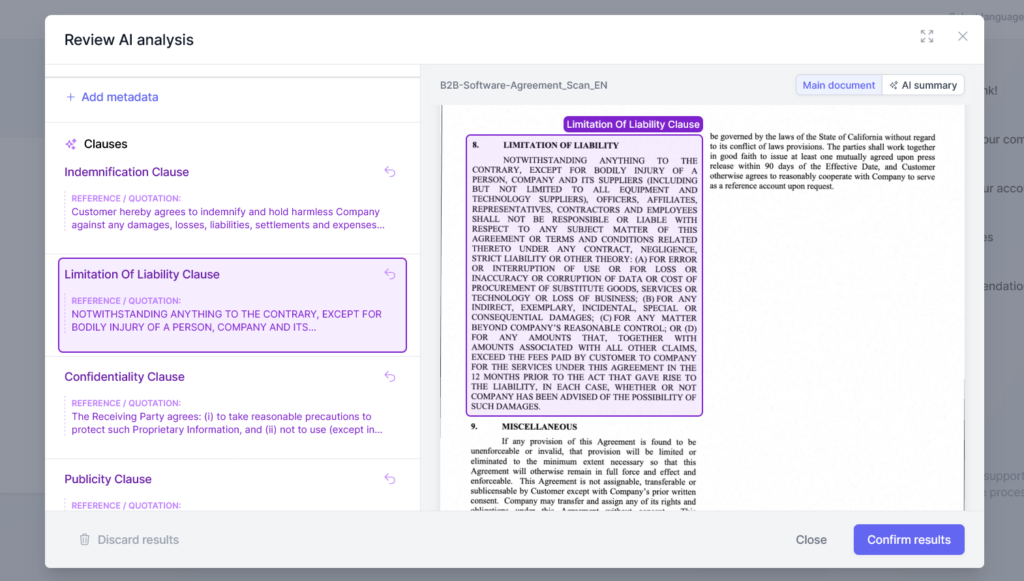
Source: fynk
This means faster decisions and less manual labor for your team.
And this is why Bulgari, for instance, uses AI for contract analysis.
As their contracts grow more complex, incorporating elements like CSR, privacy, and cybersecurity, AI helps by quickly summarizing lengthy documents and highlighting key terms.
Matteo Perondi, their Chief Procurement Officer, points out:
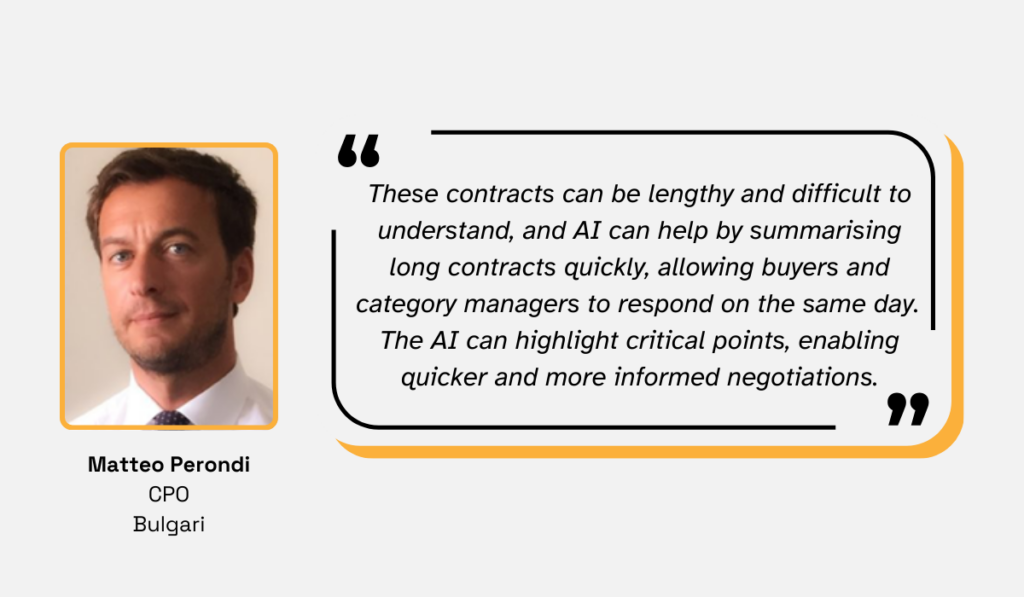
Illustration: Veridion / Quote: CPO Strategy
This enables buyers and category managers to respond on the same day, making the negotiation process quicker and more informed.
In fact, Jaggaer, who also provides a service like this, reveals that companies that leverage AI-powered tools for contract analysis reduce the time spent on contract reviews and improve efficiency by up to 60%.
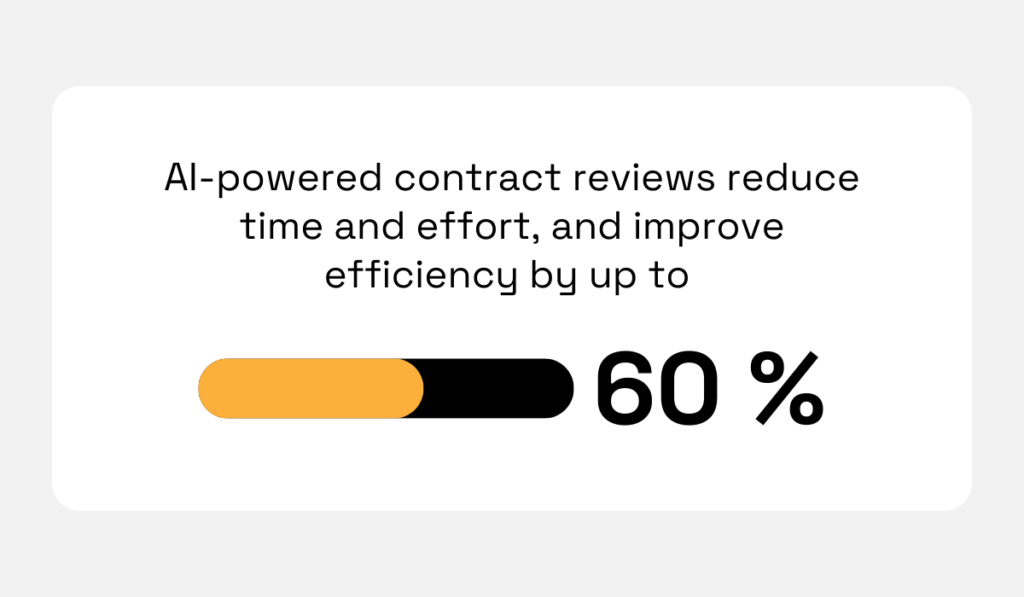
Illustration: Veridion / Source: Jaggaer
But it’s not just about saving time.
With AI contract analysis, you can also identify risks early on.
AI can flag deviations, vague wording, or unfavorable terms, so you can avoid potential pitfalls before they impact your business.
By catching these issues upfront, AI ensures you engage only with suppliers that align with your procurement goals, in turn safeguarding your operations.
With AI doing all this heavy lifting, you can focus on more strategic tasks.
So, why not take advantage of that?
It’s clear that AI is revolutionizing supplier selection and procurement, bringing efficiency, insight, and precision to every step.
From discovering and evaluating suppliers to predicting demand and analyzing contracts, AI reshapes the procurement landscape in ways we couldn’t have imagined just a few years ago.
As more companies embrace it, they build stronger supplier relationships, cut costs, and optimize supply chains for a more resilient future.
Isn’t it now the right time to explore how AI could enhance your own procurement process?